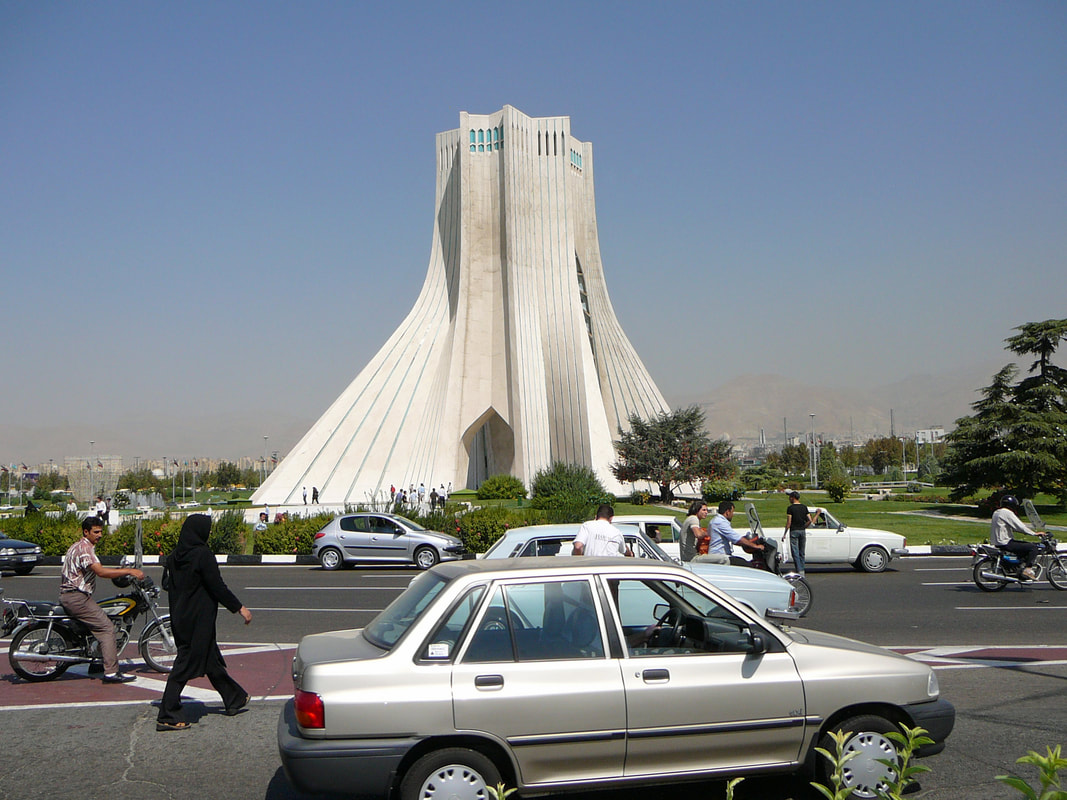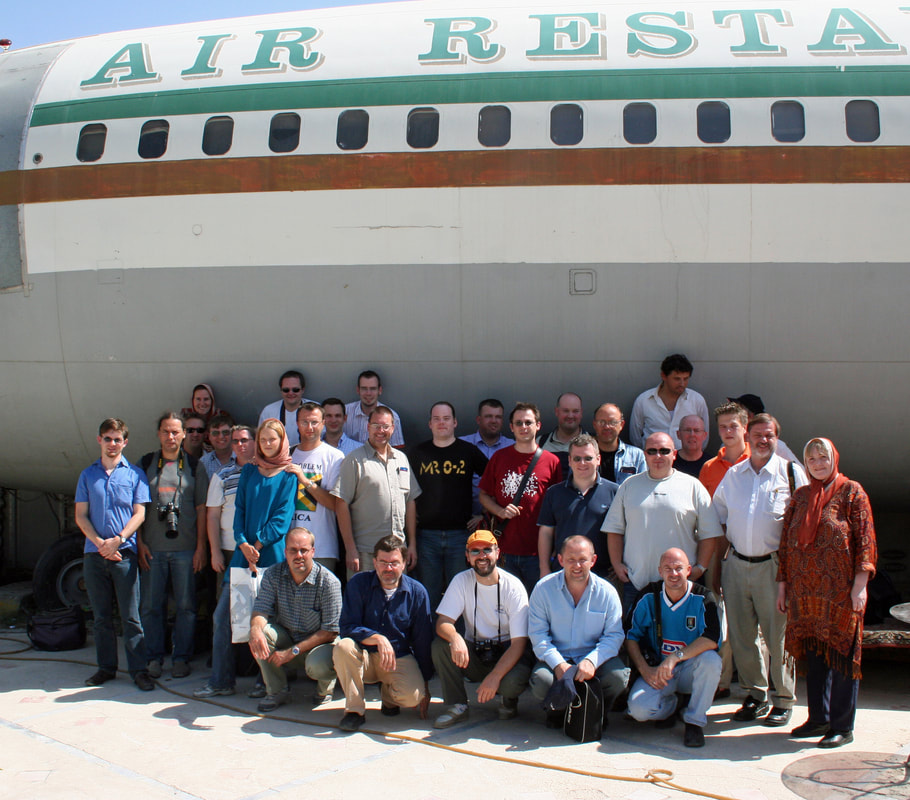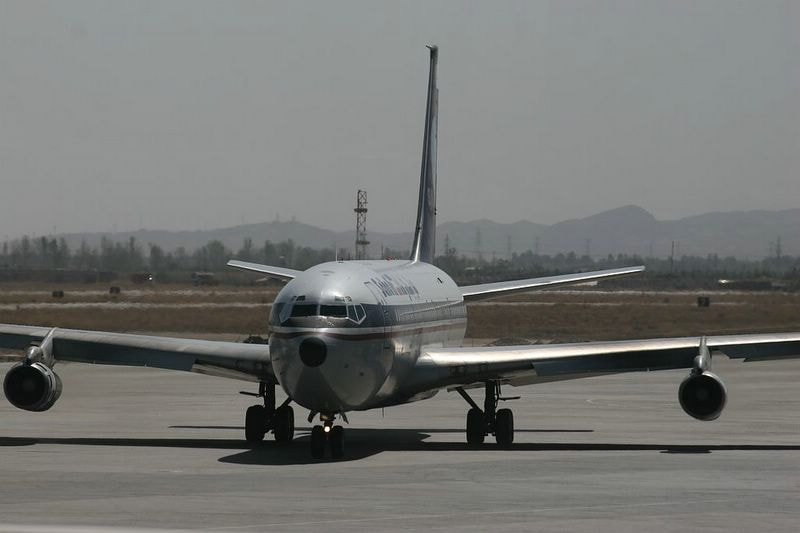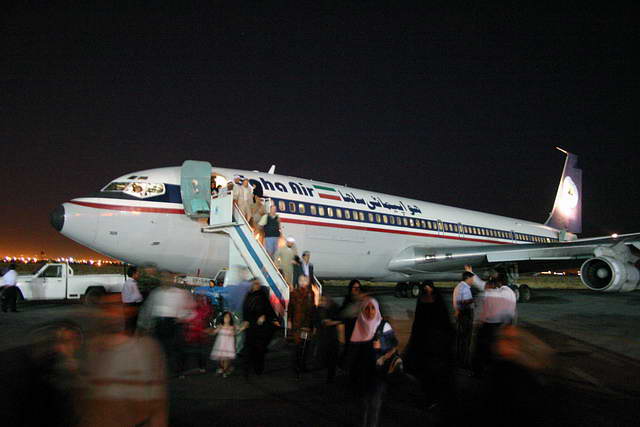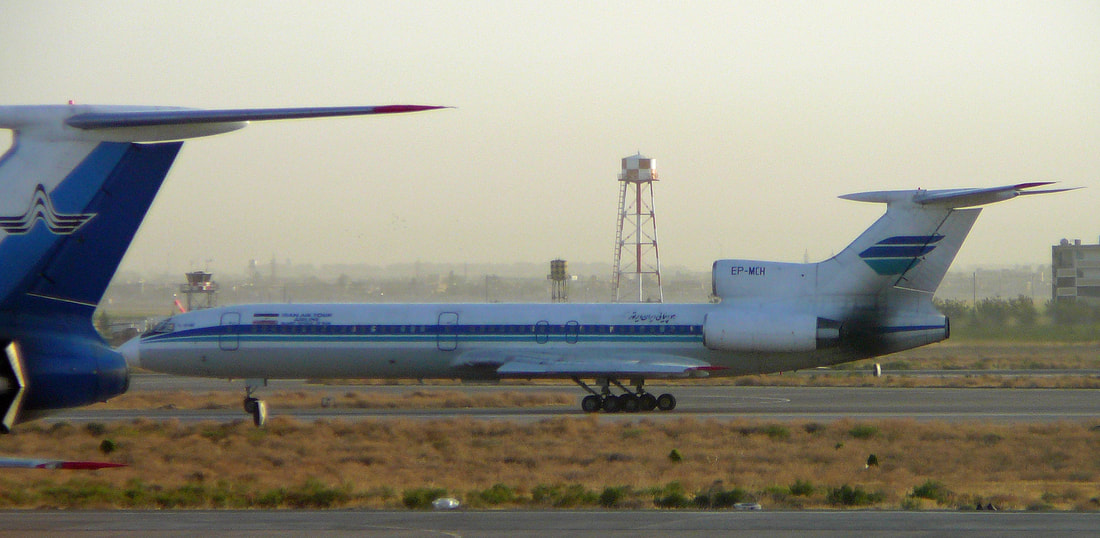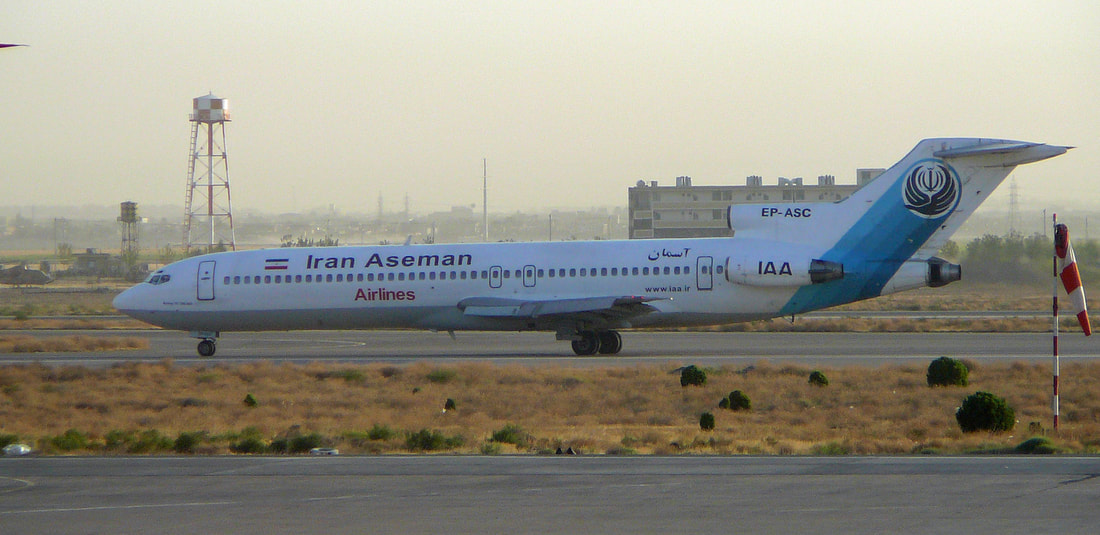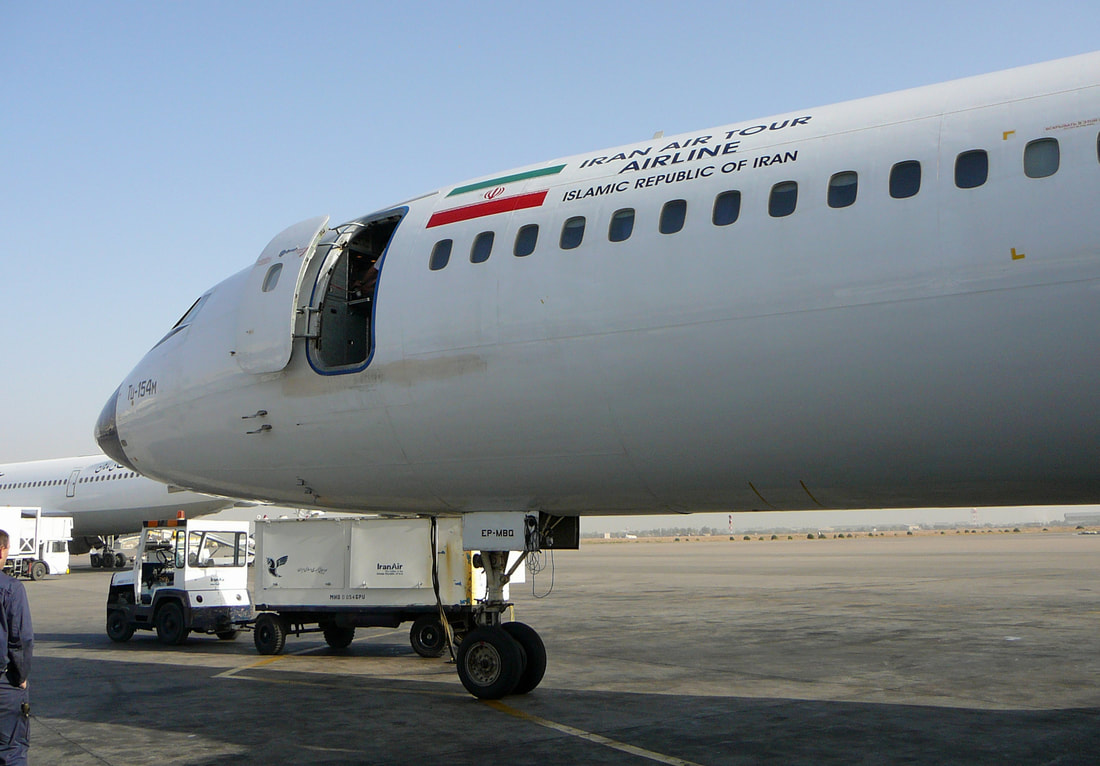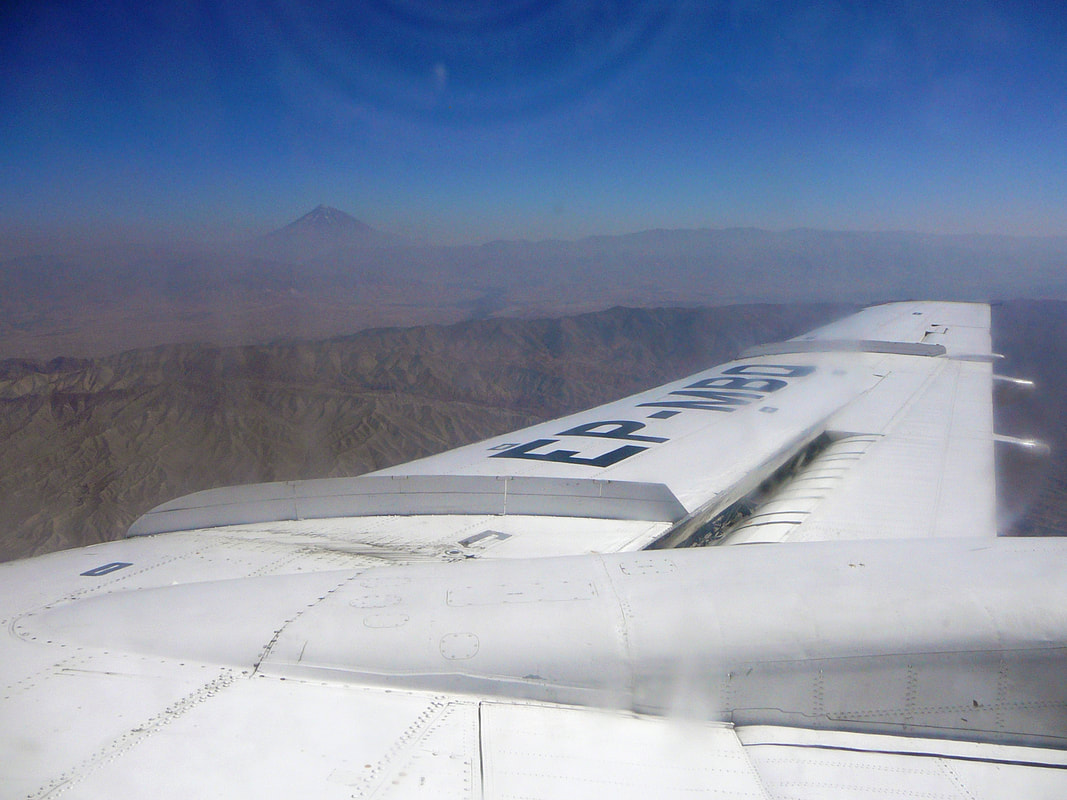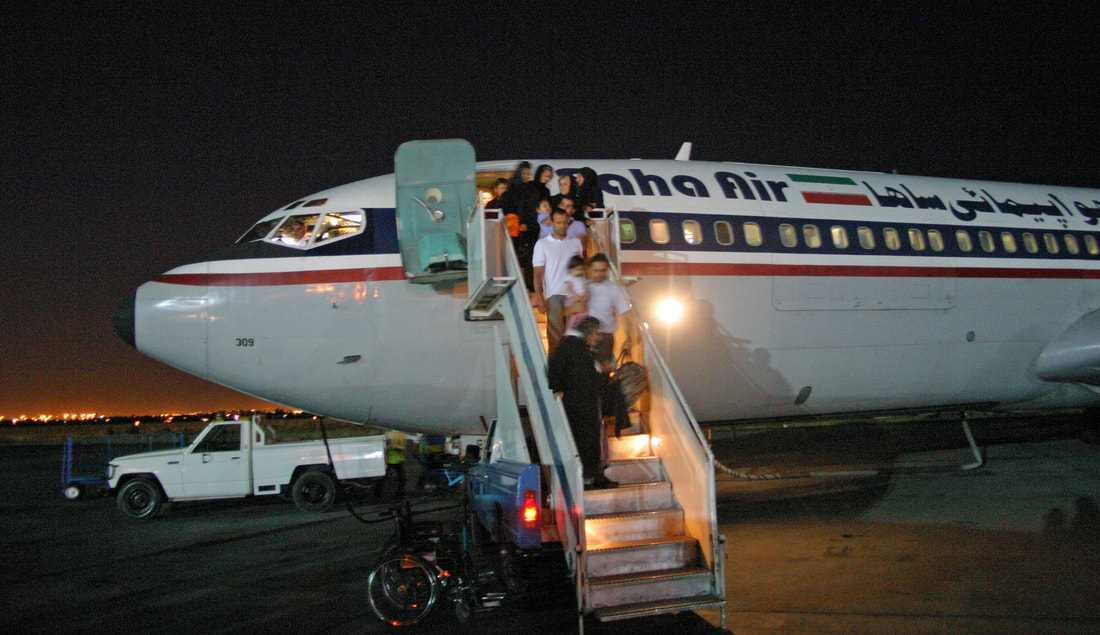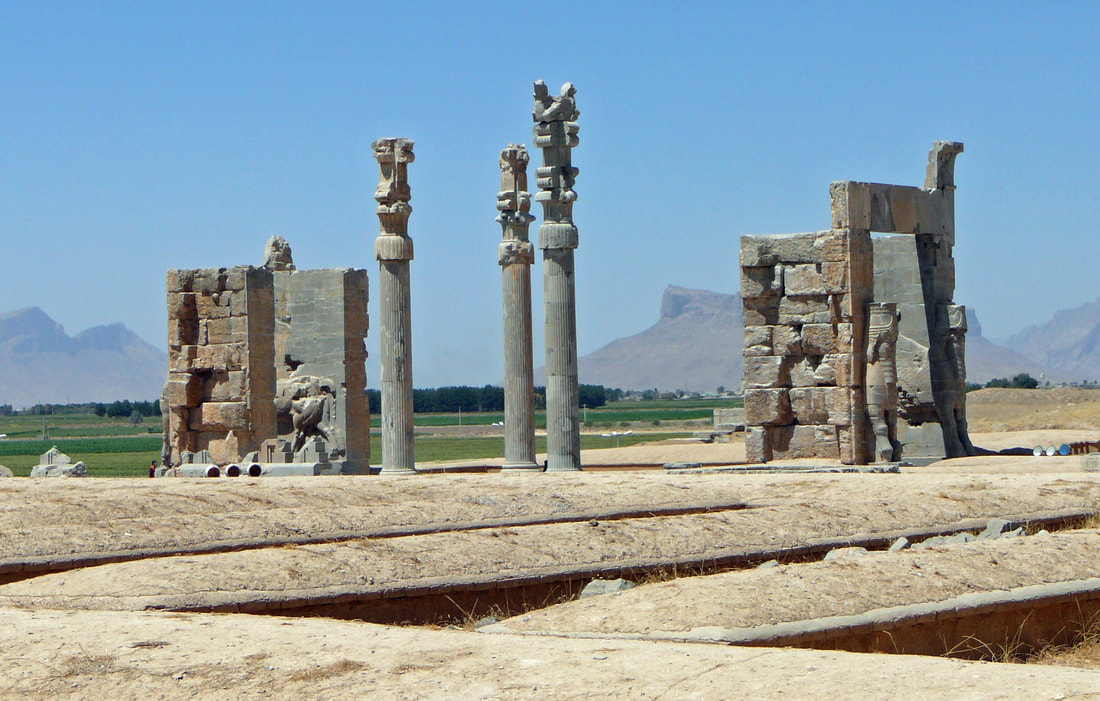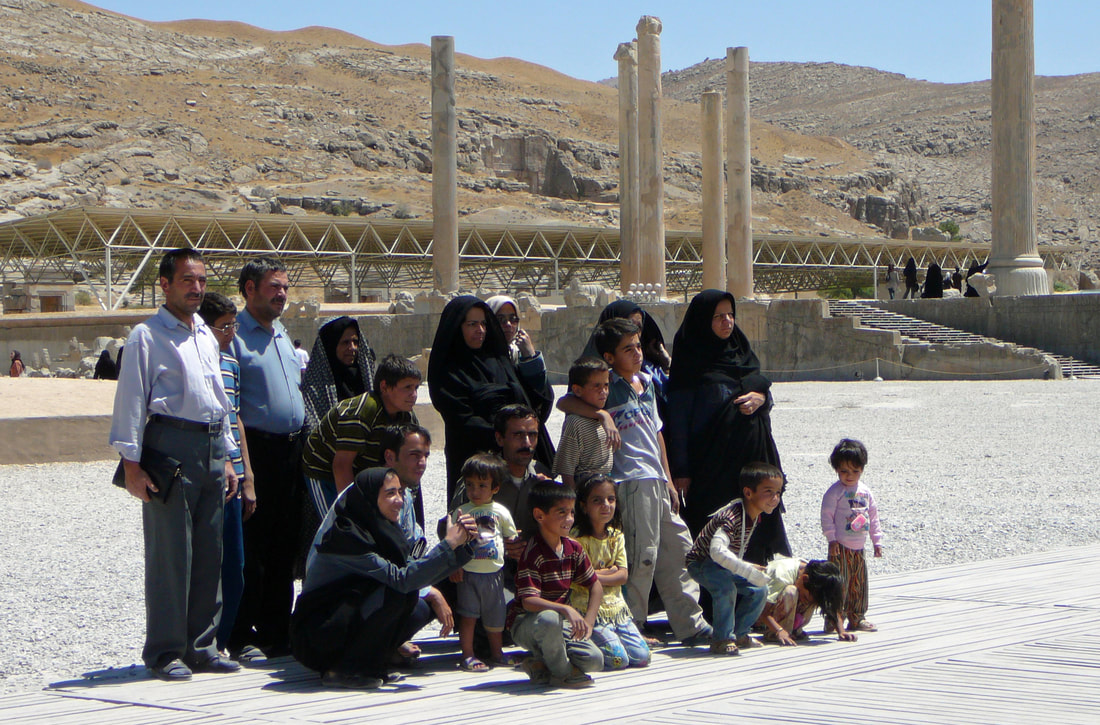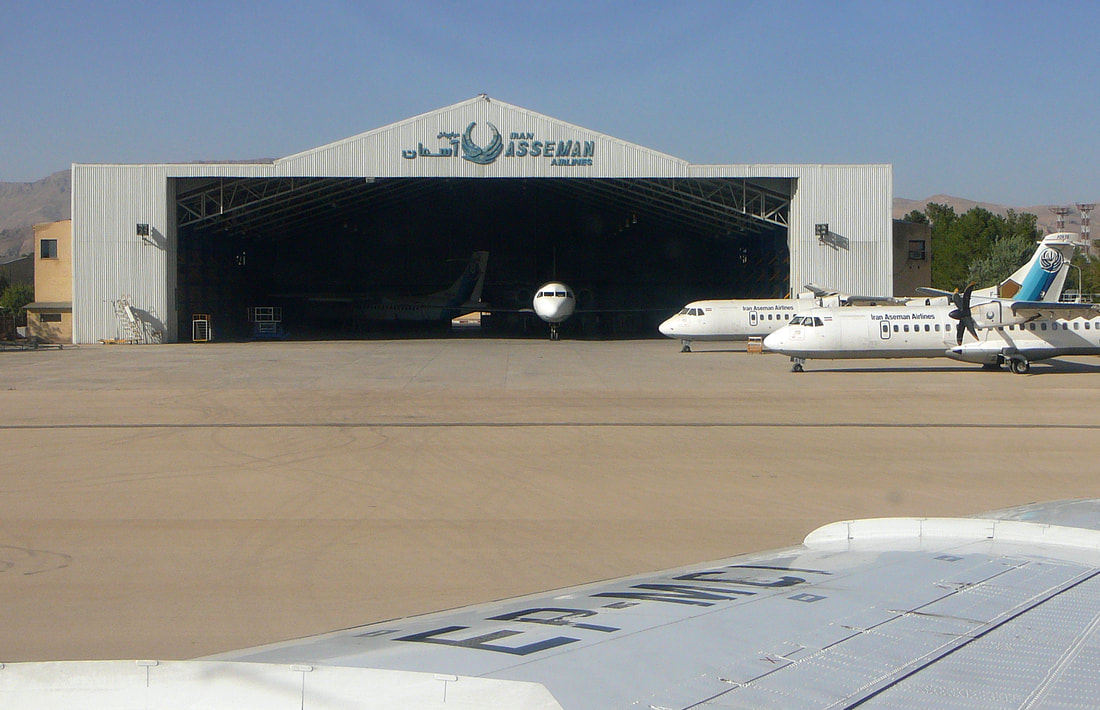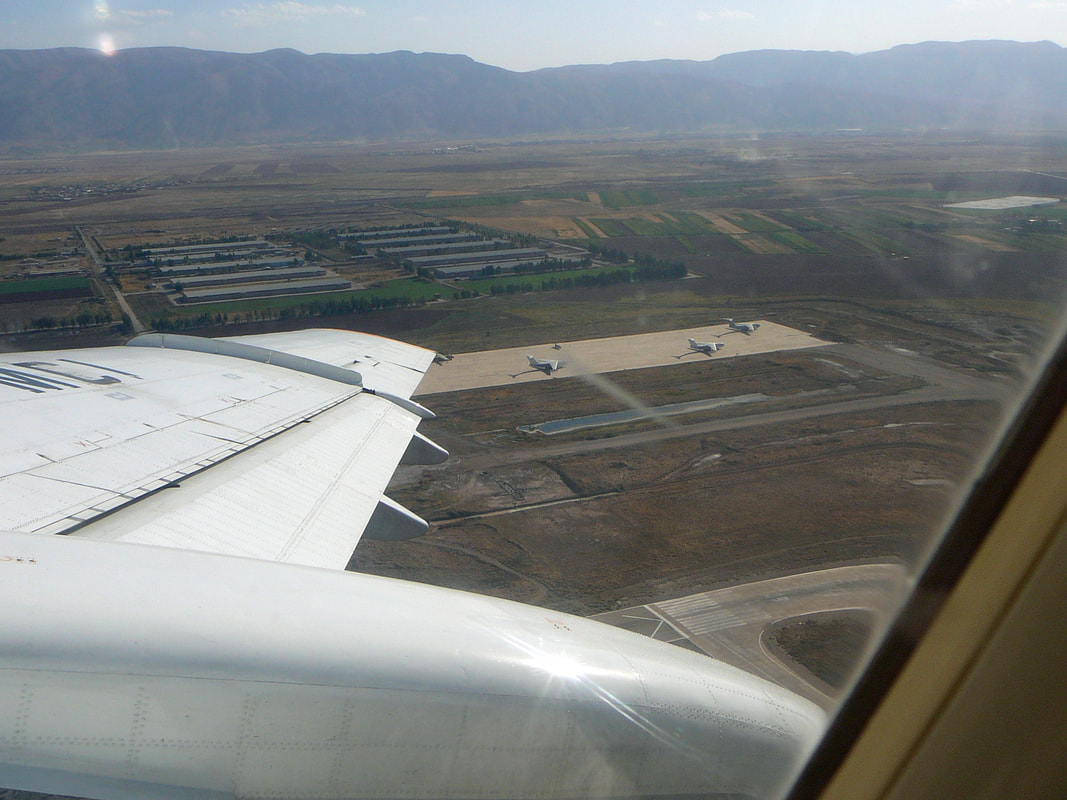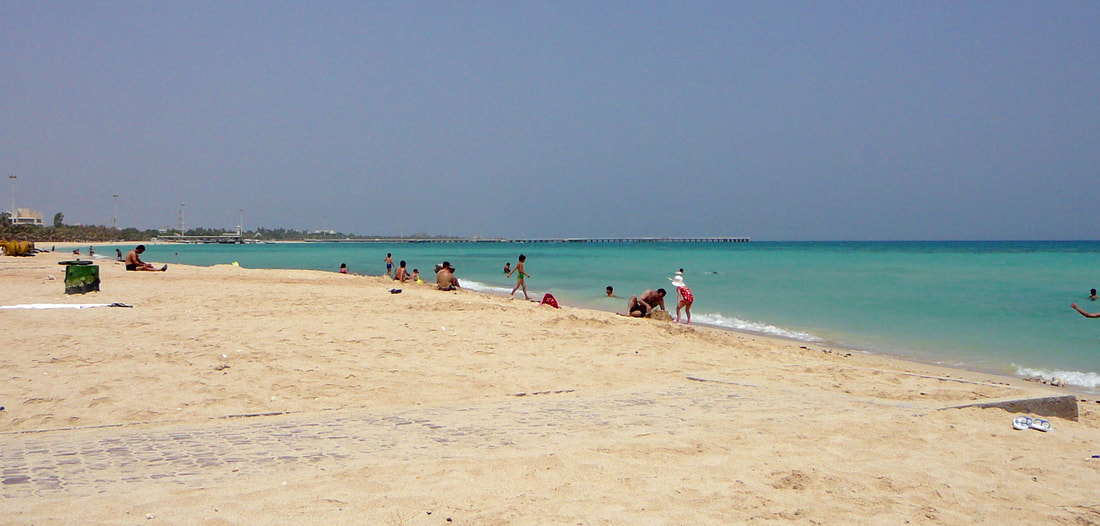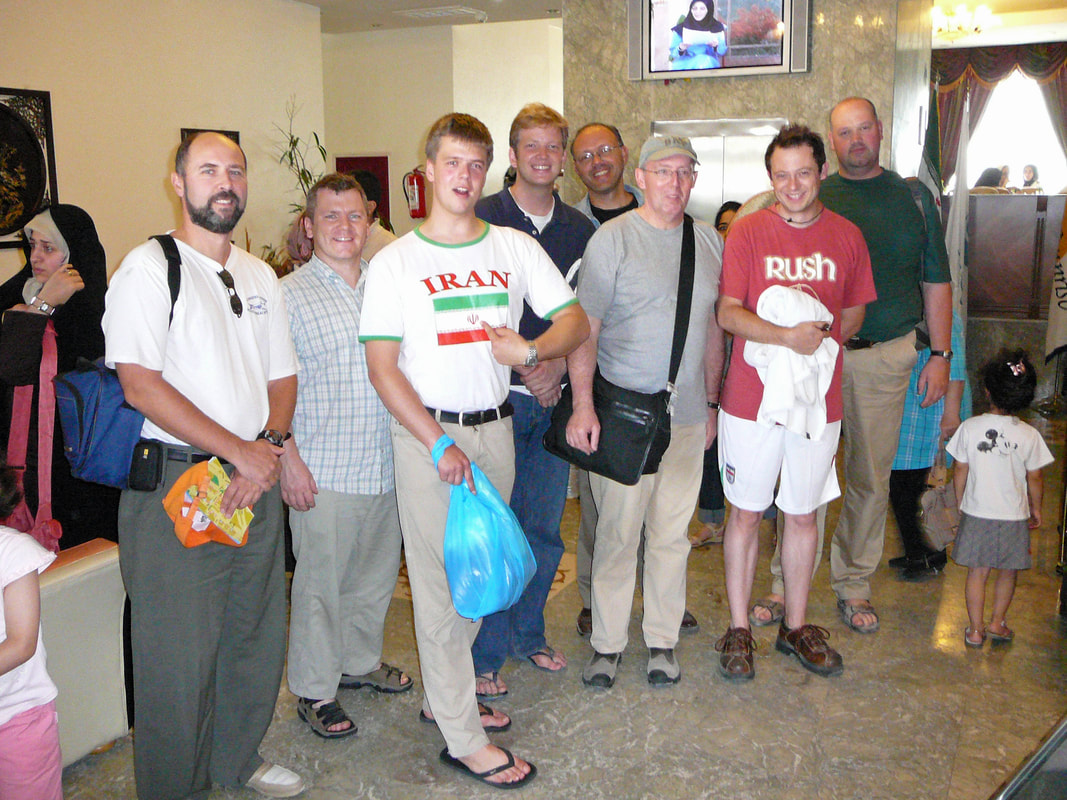Iran, 2006
By Jan Koppen
In the summer of 2006, I travelled by KLM Royal Dutch Airlines Boeing 767-200, from Amsterdam to Theran, to attend the first Air Events aviation tour to Iran.
The Azadi Tower, is a monument located on Azadi Square in Tehran, Iran. It is one of the landmarks of Tehran, marking the west entrance to the city. During the 1960s, Iran became a major oil-exporting country and using the newly-found wealth, the shah launched programs to modernize and industrialize the country. This followed a cultural growth that architect Hossein Amanat describes as "a mini renaissance". In 1966, Amanat won a competition to design the building.
Tehran; - Traffic or Warzone?
A trip to the neighborhood of Darband in North Tehran, at the foothills of Mount Tochal and the central Alborz Range, is a must. Darband, which used to be a village before becoming part of Tehran, is located at the start of the hiking trail up to Mount Tochal, which towers over Tehran and contains several popular ski resorts.
From left to right; - Charles Kennedy, Jan Koppen, Sebastian Schmitz and Johannes Krauth.
The Iran Aviation tour 2006 group and organisator Sebastian Schmitz.
Iran Air Tours flight 945 went down; - My planned Saha Air Boeing 707 flight to depart at 1400, and while we were in line for boarding, it suddenly appeared to be delayed. There seemed no reason for this. The departure lounge became more packed as also all the other Mashhad bound flights were delayed. After two and a half hours, the word spread that a Tupolev 154 of Iran Air Tours had crashed at Mashhad airport. My heart went beating must faster as I had planned to fly with Iran Air Tours the next morning. Next, we received the news that the Tupolev suffered a mishap (some reports say a nose gear tire burst) while landing on runway 14L. The airplane swerved and caught fire, killing 28 passengers onboard. I expected that all flights to Mashhad would be canceled, but suddenly boarding time for my flight was announced and started immediately. It appeared that the SAHA Air flight was the first to land at Mashhad airport after its reopening. Amongst the passengers was the minister of transport and several other high-rank officials on their way to invest in the crash. It gave me mixed feelings about the trip, as death was close by!
In-flight service was limited; - In our initial climb to 26,000 feet via Airway Bleu 411, ‘SHV’ quickly proceeded eastbound for reporting point Sabzevar. As soon as we were established on our climb-out altitude, the passengers in the cabin began to mill around and socialize. Outside, several thousand feet below us, a bright white Tupolev 154 went harrowing past towing needle-like contrails from its shiny tail, knowing that our fuel-guzzling 707 would leave an even larger corkscrew of vapor spiraling away behind us. The turbofan engines were reasonably quiet and could barely be heard in the forward cabin above the rush of the almost 600 mph air stream. The four lovely ‘chador’ uniformed air hostesses were a highlight of our 75-minute flight sector. The air attended for my section turned out to be a lovely lady with mysterious eyes and most likely a attractive body, but unfortunately she was dressed in a nothing revealing black chador! In-flight service was limited to a slice of dried-up cake and a fruit juice can with a straw. Of course, no in-flight magazine onboard this semi-military flight, only a few SAHA Air 707 safety feature cards were in the pockets of the weary seats. In the meantime our Silver Jet flashed through thin air like a rocket while passing the great salt desert Daht-e Kavi, south-east of the Elbruz mountain range. After the blood-red sliver of the sun had split the sky, we entered the darkness as we approached Mashad. At the right wingtip a double green light gleamed coldly; at the left wingtip a double red light glowed – the notice of a Jetliner rushing through the darkened skies.
Off it was on a bright sunny Friday, the first day of September 2006, rocketing down to Mashhad, Iran in merely 85 minutes, bringing back memories from our more glorious aviation past back in the 70s and 80s, from times when we were young, pure and innocent and flying onboard these classic jetliners was no less an adventure than that day in early September 2006.
Inshallah; - The old Pratt & Whitney JT-3Ds went quiet and the whispering roar of the slipstream followed the 707 down to 8000 feet for the inbound turn. The old girl shuddered and dipped as the slotted flaps eased out into the darkness rushing after the trailing edge. With Mashhad in sight, ‘SHV’descended into a gray layer of wispy cirrus clouds which caused the Boeing to slightly buffet. Droplets of condensation formed on the windows, briefly obscuring my view. As our Boeing approached the outer marker for Mashhad Airport, preparation was made for the final descent and we were able to hear the whine of the engines as the throttles were advanced to counteract the drag of the flaps.
At base-leg, I got the Runway inside, and it lay like a night-time boulevard in an oil well, brightly lit by emergency white intensity incandescent. ‘SHV’ lumbered down the slightly off-set final towards the threshold of 36 and shortly afterwards, the Jet’s landing gear was lowered causing the noise level in the cabin to increase as the units disturbed the air. The threshold lights flickered beneath the fuselage and the cabin was lit by rushing flashes and racing shadows. It seemed there was silence in those last moments and I waited, counting, waiting for the bogies to touch and rumble. The aircraft bounced heavily twice before making more permanent contact, and finally we were down and roaring along the runway. Spoilers were deployed and the four engines went into full reverse. Bellowing and howling we tore down the runway. Brakes were applied and the plane hunched down, crouching on the tarmac as she sped along. ‘SHV’ slowed gradually at first and finally the nose dipped radically. On the right hand side the smoldering remains of the crashed Iran Air Tours Tupolev 154M (EP-MCF) came into view, still surrounded by fire trucks. A shudder went through my body but the mighty Boeing 707 had brought me safely to Mashhad. The flight was most impressive and the flight-crew did a job well-done, which is a credit to SAHA Air’s longstanding 707 operations. Telling this to my neighbour, he calmly replied – “Son, he (the captain) has nothing to do with it. We were in the hands of God, - Inshallah!”.
Gingerly a ramp agent guided IRZ162 onto its assigned hardstand position and the airliner came to a halt. The roar of its engines died away and our hard working engines were ticking as they cooled. A set of steps were pushed toward the aircraft, and so ended another "routine" SAHA Air Boeing 707 flight. A sterling job done!
I had traveled aboard a wonderful classic, second-generation jet aircraft and enjoyed it very much. For ‘SHV’; it is business as usual’. Another turnaround, 20 tonnes of fuel, another crew, another varied selection of passengers and another journey”.
At base-leg, I got the Runway inside, and it lay like a night-time boulevard in an oil well, brightly lit by emergency white intensity incandescent. ‘SHV’ lumbered down the slightly off-set final towards the threshold of 36 and shortly afterwards, the Jet’s landing gear was lowered causing the noise level in the cabin to increase as the units disturbed the air. The threshold lights flickered beneath the fuselage and the cabin was lit by rushing flashes and racing shadows. It seemed there was silence in those last moments and I waited, counting, waiting for the bogies to touch and rumble. The aircraft bounced heavily twice before making more permanent contact, and finally we were down and roaring along the runway. Spoilers were deployed and the four engines went into full reverse. Bellowing and howling we tore down the runway. Brakes were applied and the plane hunched down, crouching on the tarmac as she sped along. ‘SHV’ slowed gradually at first and finally the nose dipped radically. On the right hand side the smoldering remains of the crashed Iran Air Tours Tupolev 154M (EP-MCF) came into view, still surrounded by fire trucks. A shudder went through my body but the mighty Boeing 707 had brought me safely to Mashhad. The flight was most impressive and the flight-crew did a job well-done, which is a credit to SAHA Air’s longstanding 707 operations. Telling this to my neighbour, he calmly replied – “Son, he (the captain) has nothing to do with it. We were in the hands of God, - Inshallah!”.
Gingerly a ramp agent guided IRZ162 onto its assigned hardstand position and the airliner came to a halt. The roar of its engines died away and our hard working engines were ticking as they cooled. A set of steps were pushed toward the aircraft, and so ended another "routine" SAHA Air Boeing 707 flight. A sterling job done!
I had traveled aboard a wonderful classic, second-generation jet aircraft and enjoyed it very much. For ‘SHV’; it is business as usual’. Another turnaround, 20 tonnes of fuel, another crew, another varied selection of passengers and another journey”.
|
Avgeeks at breakfast in Mashhad airport.
The second-largest holy city in the world, Mashhad attracts more than 20 million tourists and pilgrims every year, many of whom come to pay homage to the Imam Reza shrine (the eighth Shi'ite Imam). It has been a magnet for travelers since medieval times. Thus, even as those who complete the pilgrimage to Mecca receive the title of Haji, those who make the pilgrimage to Mashhad—and especially to the Imam Reza shrine—are known as Mashtee, a term employed also of its inhabitants. As an important problem, the duration when new passengers stay in Mashhad has been considerably reduced to 2 days nowadays and they prefer to finish their trip immediately after doing pilgrimage and shopping in the markets.
|
The very low morning light catches these Tupolev's half-asleep on the ramp at Mahsad - Shahid Hasheminejad International Airport.
The bright yellow/blue tail of Iran Air Tours Tupolev Tu-154M EP-MBT (c/n. 930) stands out against the gloom of a September day at Mashhad, Iran airport in 2006.
|
Originally delivered to Aeroflot in August 1993 as RA-85747, the Tupolev passed through a succession of owners, including Aerokuzbass and Aria Airtour, before ending up with Iran Air Tours Airlines in May 2004. She was retired from service and flown to Theran - Merabad for storage in January 2012. In 2019 she was still parked at Merabad in good condition.
|
Early morning shot of Kolavia Tupolev Tu-154M RA-85787 did operated for AriaAir.
|
The, in 1994 manufactured Tupolev Tu-154M, started her airline career with Aeroflot in Russia as RA-85787. Two years later, in 1996, she was sold to Kogalym based, Kolavia. In November 2006 she was leased by Iranian Taban Air who used her intra-Iran flights.
On Sunday January 24, 2010, the Tupolev, operated by Taban Air, was destroyed in an accident at Mashhad Airport, Iran. There were 157 passengers and 13 crew members on board. Some 46 passengers were injured. Taban Air flight 6437 originated in Abadan Airport and diverted to Isfahan because of poor weather at Mashhad Airport. When weather conditions had improved, the flight left Isfahan at 05:35. En route the visibility deteriorated again, forcing the crew to enter a holding pattern. While waiting for the fog to clear, one of the passengers became seriously ill. Despite the limited visibility, the captain declared a medical emergency and attempted to land at Mashhad. During the landing the tail struck the ground. The right wing also struck the ground as the airplane veered off the runway. The undercarriage collapsed and a fire erupted. |
Iran Air Tours leased Tupolev Tu-154M EP-MCH (c/n. 91A897) from Kras Air.
Originally delivered in August 1991 to Aeroflot as CCCP-85704, this aircraft retired after only four years’ service with the Russian airline and was bought in 1995 by Air AJT. The Tupolev then changed hands in March 1997 when it was operated by Iranian Kish Air as EP-LAV. After flying only one year with Kish, she returned to Russia and Kras Air became her new owner. After eight years she was exported to Iran again and Iran Air Tours became her proud owner. After only three years in Iran she returned to Russia again and operated for Zapolyarye for her remaining service life. She was withdrawn from service and stored at Domodedovo in the summer of 2008.
A classic image of Iran Aseman Boeing 727-200 EP-ASC in its original passenger configuration, photographed taxying at Mashhad International Airport in 2006.
Iran Air Tours leased Tupolev Tu-154M EP-MCL (c/n. 91A880) from Siber and is seen her taxiing out at Mashhad on September 02, 2006.
EP-MHG taxied out for take-off at Mashhad.
The long fuselage of Caspian Tupolev Tu-154M EP-CPO reflects the North Khorasan morning light as it is replenished with stores for its return flight from Mashad to Theran in September 2006.
The aircraft was almost 14 years old when captured on film in September 2006 and had seen service with Cairo Charter in Egypt and Mahan in Iran, before beginning a long career with Caspian Airlines. During February 2011 she has been withdrawn from use and is presumably still stored at Theran - Mehrabad.
Iran Air Tours Tupolev Tu-154M EP-MBQ is seen here at Mashhad awaiting its passengers before the flight back to Theran, Iran.
Another very efficient turn-round for this Iran Air Tours Tupolev Tu-154M.
Tupolev Tu-154M EP-MBQ almost ready to depart her stand at Mashhad with another load of passengers.
Iran Air Tours Tupolev Tu-154M EP-MCF (c/n. 88A788). The Tupolev suffered a mishap (some reports say a nose gear tyre burst) on September 01, 2006, while landing on Mashad's runway 14L. The airplane swerved and caught fire.
Iran Air Tours Tupolev Tu-154M taxing out for departures with a company Tupolev and a Qeshm Airlines A300 in the background.
Tupolev Tu-154M EP-MBQ leaves Runway 13R at Mashhad in September 2006 with a full load of passengers bound for Theran.
Off it was on a bright sunny Saturday, start of September 2006.
Level, just above the ridges of the Elbruz mountains, enroute from Mashhad to Theran.
She made contact with the runway.
Wing fences, also known as boundary layer fences and potential fences are fixed aerodynamic devices attached to aircraft wings. Often seen on swept-wing aircraft, wing fences are flat plates fixed to the upper surfaces parallel to the airflow, typically wrapping around the leading edge. By obstructing span-wise airflow along the wing, they prevent the entire wing from stalling at once, as opposed to wingtip devices, which increase aerodynamic efficiency by seeking to recover wing vortex energy.
Saha Air Boeing 707-320 EP-SHV (c/n. 21125).
The JT3D—3B engines are readily identifiable by the large gray secondary air inlet doors in the nose cowl. These doors are fully open (sucked in at the rear) during takeoff to provide additional air. When the engines are throttled back to cruise, the doors are shut.
Another quick turnround for EP-SHV as it disembarks passengers from Theran, at Shiraz.
Hit the road with destination Petropolis.
Petropolis, 515 BC.
Persepolis was the ceremonial capital of the Achaemenid Empire (ca. 550–330 BC). It is situated 60 km northeast of the city of Shiraz in Fars Province, Iran. The earliest remains of Persepolis date back to 515 BC. It exemplifies the Achaemenid style of architecture. UNESCO declared the ruins of Persepolis a World Heritage Site in 1979.
We were not the only one, it seems to be a favourite outing for Iranian family's.
Iranian women are very beautiful because of Persian genes.
This beauty is filming all those attrative blond Europeans!
Iran Air Tours Tupolev Tu-154M EP-MCI prepares for departure from Shiraz to Kish Island.
Iran Aseman Airlines ATR-72 EP-ATS.
Strange; - on the aircraft its Aseman and on the hangar Asseman airlines!
Iran Air Force Pilatus Potters are seen here gleaming on Shiraz AFB apron in September 2006.
Picked out well by the summer light is the complex array triple-slotted trailing edge flaps of Iran Air Force IL-76MD 5-8201.
A ground power unit pumps energy into stationary Iran Navy P-3 Orion 5-8706, as she sits on the ramp at Shiraz AFB, Iran.
Iran Air Force Ilyushin IL-76TD 5-8204, on a broiling hot Shiraz tarmac in September 2006.
With a midday temperature of 40 degrees centigrade, Iran Air Force Ilyushin IL-76MD Simorgh, is sitting pretty at Shiraz AFB, Iran.
Parked next to the taxiway of Shiraz Airport, camouflaged Ilyushin IL-76TD 5-8206, watches our Tu-154M EP-MCI, taxing out for departure.
The thundering Jet rushes upward into the air
Time for relaxation. Kish island beach - mens only!
Avgeeks in Iran. The year 2006.
The Greek Ship is the nickname of a cargo steamship, Khoula F, that has been beached on the southwest coast of Kish Island, Iran, since 1966. She was built in 1943 by the British shipyard of William Hamilton and Company in Port Glasgow, Scotland, under the name Empire Trumpet. From 1946 to 1966, she passed through a series of British and Iranian owners and various changes of name. Her final owners were Greek, and the nickname given to her derives from them.
- The End -
